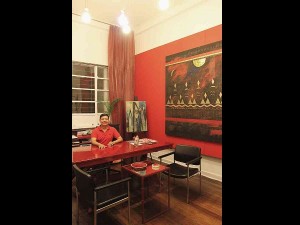
Trust art broker Albert Avellana to always think out of the box, especially when celebrating his 50th birthday.
Every day from midnight of June 11 to July 31, friends and relatives have been and will be hosting lunches, tea parties, cocktails and dinners to add up to 50 intimate celebrations.
Every June 12—Avellana’s birthday—he always holds a big party at the Avellana Arts Gallery which also coincides with the opening of an exhibit and Independence Day.
“I’m guilty. People have been telling me they don’t want to attend the party because there are too many guests, and I don’t talk to them. After a minute of small talk, I disappear. I said to myself, what if I do 50 birthday parties?”
Last June 11, Avellana’s longtime friend and patron Marivic Vasquez organized a dinner for 12 at Café Adriatico. Everybody was asked to wear red, Avellana’s signature color.
Since then, parties have been lined up by designers, artists, relatives, art cognoscenti—interior designers Tina Bonoan, Darla Villalon, Opat Hermano, Penny Zaide, Becca Kaisip, George Martinez of Don Bosco, architect Dan Lichauco, photographer Philip Escudero, Tuchi Imperial, nephews and nieces, fashion designer Jojie Lloren, the Printmakers Association of the Philippines, Deanna Ongpin, former Penguin buddies, Leo Aldana, designer Ricky David.
In Bacolod, he will be feted by scion Adrian Lizares, furniture designer Bernie Sason, Lisa Montero, Bong Zubiri, to name a few.
Bubot Caluya culminates the 50-day celebration of 50 years. These are small groups, so Avellana can spend quality time with them.
Friendship-based
“Those 50 birthday celebrations are friendship-based. That is also how I run the gallery. Everything is relationship-based. I don’t bind the artist in a contract.”
His roster now includes nearly 50 artists.
Avellana’s recent birthday bash not only marked the 10th anniversary of his gallery in Pasay City but also his longtime association with artist Eugene Jarque, his first protégé. He discovered Jarque when the latter was a student at the Technological University of the Philippines. Jarque’s exhibit presents his penchant for unusual shapes and colors rendered in acrylic, fabric and layers of stripped woods.
No pretty pictures, social realism or angsty pieces have ever been displayed on those walls.
“I’m too happy,” Avellana says with a chuckle. “Angsty pieces don’t work here. I’m always looking for something original—yung natataranta ako (something that bewilders).”
Artistic genes
Avellana comes from a family of artists. His father, Angel Avellana, was a prominent sound engineer in the film industry, elevated to the Famas Hall of Fame after winning for six consecutive years. He worked on such films as “Ang Pinakamagandang Hayop sa Balat ng Lupa,” “Mga Anghel sa Lupa,” “Asedillo” and other Fernando Poe Jr. classics.
His uncle is National Artist for Film Lamberto Avellana. During the wake of his aunt Daisy Avellana, National Artist for Theater, he styled the chapel with white flowers and tall grass, Daisy’s urn and portrait floating above them. The viewing area was arranged as a quiet space while the rest of the visitors talked outside.
Avellana cultivated his aesthetics from his fine arts training at the Philippine Women’s University. Although his first job was selling carpets and etched glass, he discovered his talent in finding tasteful artworks and selling them. He also had a stint in theater, joining the chorus of Gantimpala Theater’s “Magsimula Ka” and Repertory Philippines’ “Fiddler on the Roof.”
He then helped out the late artist Sid Hildawa in his gallery, curated the exhibits at Alliance Française and helped in the cultural affairs of the then newly established Instituto Cervantes.
In 1997, Avellana opened his first gallery at San Juan Apartments. Meanwhile, he also mounted exhibits for the Hotel InterContinental and Peninsula Manila. When interior designer Josephine Labrador Hermano took over Design and Architecture magazine (now defunct), Avellana was tasked to be the pictorial director.
Caring friend
Our friendship with Avellana dates back to 1989. In a party at Hermano’s house, the owner showed the photos of her abode and was displeased by the photographer’s lack of perspective. I was still working for another newspaper.
When we asked permission to photograph her house, she asked Avellana to guide the photographer, Teddy Pelaez.
Avellana taught photographers about mood for interiors using available lighting, depth of space and background and foreground. Through the years, Albert also helped me by directing the fashion shoots. The clothes were also set against striking architecture, whether it was vintage Chanel and Azzedine Alaia clothes set against the Philamlife Building, or Joe Salazar’s gowns in front of Ruby Roa’s Asian-inspired getaway in Cavite.
Albert is also a caring friend. When we were photographing the penthouse of an interior designer, I accidentally ran into glass panel door. The designer-owner didn’t even apologize or offer to give me first aid. Albert brought me to the emergency room of the nearest hospital to stop my nosebleed.
Bright ideas
One of Avellana’s bright ideas was to organize a fashion show for the Inquirer inside the MRT just before its launch in 1999. We asked the Metro Rail Transit Corp. to provide us the train ride, which was set on the eve of its inaugural trip with President Joseph Estrada.
Albert Almedralejo helped to produce the event, while Joey Espino directed the six designer-collections. Guests entered the North Avenue station. At every stop, a new batch of models from a different designer entered the carriages. The ride ended at the Shaw Boulevard station with a Bench fashion show. That was arguably the only time Manila’s social set ever rode the MRT.
Avellana’s fertile imagination keeps on running. From his birthday to June 11, 2014, he will curate 50 exhibits—some at Café Escudero in Quezon City, others in Bacolod, and at Plaza del Norte in Laoag.